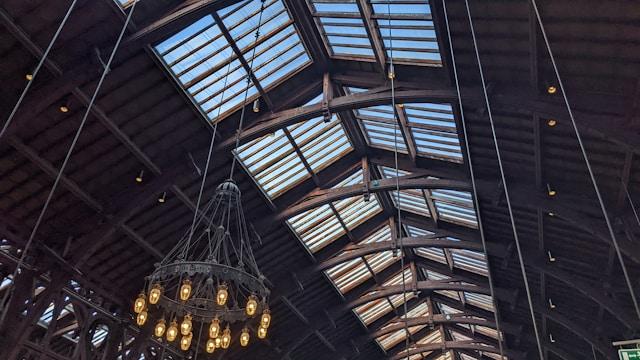Energy expenses continue increasing, creating heightened homeowner awareness regarding monthly utility cost reduction. Though most individuals focus on appliance upgrades or insulation improvements, frequently overlooked solutions exist overhead. Skylight installations provide adequate natural illumination, ventilation, and temperature regulation combinations that substantially influence energy consumption and monthly expenses.
Modern homeowners encounter average 3% to 5% annual utility increases, with electricity and heating being the primary expenses. Skylights transform roofing from passive barriers into active energy conservation systems functioning continuously throughout days and seasons, delivering quantifiable monthly expense reductions. Here’s how a skylight roof can help you save on energy bills.
Natural Light Reduces Artificial Lighting Needs
The immediate advantage of skylight installation is the substantial reduction in artificial lighting requirements during daylight periods. Strategically positioned skylights illuminate interior environments three times more effectively than equivalent-sized vertical windows. This enhanced light distribution enables extended electric lighting deactivation throughout the day.
Skylight positioning and angles capture sunlight continuously from morning through evening, providing consistent light following solar movement. Unlike lateral windows receiving direct light during limited daily periods, overhead skylights maintain steady illumination levels, eliminating supplemental electric lighting requirements under most conditions. Throughout annual cycles, this lighting usage reduction potentially decreases electricity consumption by 10% to 15%.
Passive Solar Heating During Winter Months
Skylights positioned to face south or southeast maximize solar energy capture when winter’s lower sun path provides optimal conditions. This natural solar heating directly warms indoor areas, lessening demand on your home’s heating equipment. Sunlight flowing through these overhead windows can increase room temperatures by multiple degrees through purely passive means.
Modern skylight designs feature specialized low-E coatings that welcome solar warmth indoors and block heat loss from your home’s interior. This targeted thermal performance reduces heating system operation during bright winter weather, creating noticeable decreases in energy expenses.
Reduced Heat Island Effect in Upper Floor Areas
Traditional roofing materials absorb solar radiation and transfer heat into living spaces like upper floors and attic areas. Skylights interrupt this heat absorption pattern. They allow solar energy to pass through rather than accumulating in roofing materials. Professional installation companies like Sunsquare Limited understand how proper skylight placement can significantly reduce the heat island effect that forces cooling systems to work overtime.
The glazing in quality skylights reflects some incoming solar radiation while allowing visible light to pass through. This selective reflection prevents excessive heat buildup in roof structures while providing beneficial natural lighting. The result is cooler attic spaces and upper floor rooms that require less mechanical cooling to maintain comfortable temperatures.
Smart Technology Integration
Modern skylight installations feature intelligent sensors and automated mechanisms that maximize energy efficiency across varying weather patterns. Moisture detectors automatically seal operable skylights when precipitation begins, while thermal sensors can activate opening and closing sequences that enhance natural airflow advantages.
Specific premium skylight systems utilize dynamic glazing technology that modifies light transmission according to ambient conditions. This technology blocks unwanted heat buildup during intense summer periods while promoting helpful solar warming throughout winter. These innovative systems guarantee that skylights deliver peak energy performance despite seasonal shifts or daily climate fluctuations.
Enhanced Natural Ventilation and Air Circulation
Opening skylights establishes effective ventilation networks that leverage natural airflow patterns and heat dynamics. Since warm air naturally moves upward, venting skylights offer an exit path that pulls fresh air through ground-level openings such as windows and doorways. This chimney-effect ventilation decreases dependency on cooling equipment and electric fans.
The upward airflow generated by opened skylights can drop interior temperatures by 5 to 10 degrees versus closed-up spaces. This organic cooling approach can completely replace air conditioning needs during temperate spring and autumn weather. Even in hot summer conditions, the improved air movement shortens cooling system operation times, reducing energy costs significantly.
Improved Indoor Climate Control Efficiency
Skylights promote steadier indoor climates, minimizing the temperature swings that force HVAC equipment to operate more intensively. Daylight streaming through overhead windows heats indoor surfaces uniformly across the day, eliminating the chilly zones commonly forming in interior rooms lacking direct sun exposure. This thermal consistency allows heating and cooling systems to maintain comfortable conditions while consuming less energy.
The balanced heat delivery from skylights also prevents moisture fluctuations that can create discomfort even at moderate temperatures. With stable humidity conditions, residents remain comfortable at warmer summer settings and cooler winter temperatures, enabling more energy-efficient thermostat programming throughout all seasons.
Extended Lifespan of HVAC Equipment
Skylights decrease the operational demands on heating and cooling equipment. They prolong system longevity and minimize maintenance needs. Mechanical components endure reduced stress as HVAC units run less often thanks to enhanced natural light and airflow. Blowers, condensers, and heating elements all benefit from fewer operational cycles.
This prolonged equipment durability results in postponed replacement expenses and diminished repair costs over the long term. Though skylight installation requires initial capital investment, the decreased HVAC servicing needs and extended system life deliver continuous financial returns that compound over many years.
Endnote
Skylight installation constitutes a calculated investment that produces quantifiable benefits through diminished energy usage across various home systems. The combined impact of reduced electricity bills, decreased climate control costs, and prolonged HVAC system durability generates significant savings that accumulate progressively over the years.

